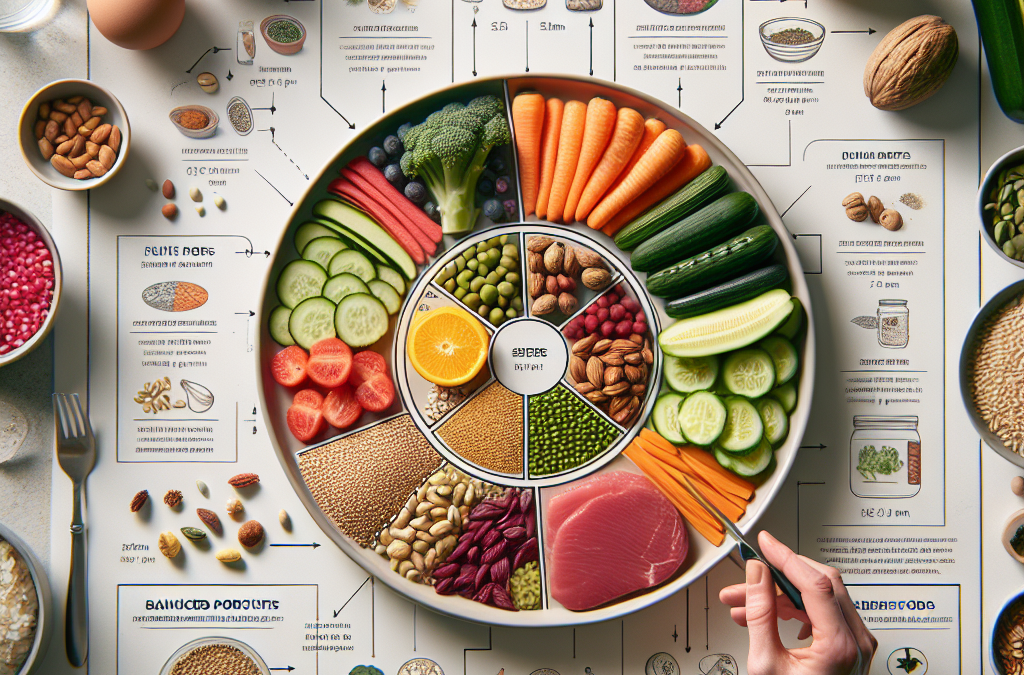1. Embrace Whole, Unprocessed Foods
Understanding Whole Foods
When I first started my journey with whole foods, I learned that these are essentially foods that are as close to their natural state as possible. We’re talking veggies, fruits, whole grains, nuts, and seeds—pure, simple goodness. The beauty of these foods is that they tend to be loaded with nutrients, yet low in added sugars and unhealthy fats.
Replacing processed snacks with whole foods made a significant difference for me. It’s easy to underestimate how much ‘added junk’ can pack on the calories without any nutrients. By sticking to whole foods, not only do I feel better physically, but I also have more energy throughout the day.
Plus, the taste of fresh, whole foods is unmatched. Trust me, popping a ripe peach in your mouth feels a whole lot better than munched-down chips. So, get familiar with what whole foods look like in your store or local market—the next time you shop, try filling your cart with these nutrient-rich treasures!
Learning New Recipes
Over time, I discovered that one of the most fun parts of eating whole foods is experimenting with new recipes. I’ve spent countless weekends scouring the web for simple, healthy recipes that highlight seasonal ingredients. Each new recipe is a little adventure, trust me!
Cooking from scratch isn’t just healthier; it’s also a great way to connect with what you’re eating. I learned that meal prepping with whole ingredients can save time and guarantee that I’ve got something wholesome and delicious ready to go.
And let’s be real—getting creative in the kitchen with whole foods can lead to some seriously tasty meals. Roasted veggies drizzled with olive oil and sprinkled with spices? Yes, please! You may even find that trying new things becomes one of the highlights of your week.
Mindful Eating
Another important aspect of maintaining a healthy weight is being mindful of how I eat. It’s not just what I eat, but how I consume it. I’ve learned to savor each bite, focus on the flavors, and really enjoy my meals. When I do, I find that I’m less likely to overeat.
Often, I put away the distractions—like screens—and sit down at the table with my meal. This simple act allows me to appreciate my food more, slowing down enough to notice when I’m satisfied, rather than just mindlessly munching.
Being present during meals has shown me how easy it is to recognize true hunger cues. I discovered that I don’t need to clean my plate if I’m full; it’s okay to leave some food behind. This new mindset has truly transformed my relationship with food.
2. Focus on Plant-Based Foods
The Benefits of a Plant-Powered Plate
Switching to a plant-based lifestyle has been eye-opening for me. Incorporating more fruits and veggies directly impacts how I feel. When I load my plate with colorful produce, I feel more energetic and less bloated. It’s almost like my body perks up with each vibrant bite!
Plus, plant-based foods tend to be higher in fiber, which keeps me fuller for longer. I’ve found that dishes like quinoa salads and veggie stir-fries not only satisfy my hunger but also keep my cravings at bay throughout the day.
Don’t get me wrong—there’s no need to ditch everything else. I just focus on making plants the stars of my meals and the other stuff the sidekicks. It adds variety to my diet and keeps things interesting!
Getting Creative with Plant-Based Ingredients
Alright, let me share a little secret: cooking with plant-based ingredients opens a whole new world of culinary fun. From making creamy avocado spreads to sweet potato-based burgers, the options are literally endless! It’s like being an artist, but instead of a brush, I’ve got a spatula.
I often challenge myself to concoct plant-based versions of my old favorites. For instance, swapping traditional pasta for spiralized zucchini or cauliflower rice. They’re super filling and way less carb-heavy compared to their counterparts!
Trying different international cuisines is a great way to explore plants, too. Thai, Indian, and Mediterranean dishes often center around plant-based ingredients that are bursting with flavor. I love the diversity and I’m never bored with my choices!
Learning About Nutritional Balance
One thing I had to learn on my journey is that while whole foods and plants are fantastic, nutritional balance is key. I started paying closer attention to how I was building my meals. A good mix of protein, healthy fats, and carbohydrates is essential to maintain energy levels throughout the day.
For example, instead of just piling a salad with only greens, I now add some chickpeas for protein, nuts for healthy fats, and maybe a sprinkle of feta for flavor. It transforms my meals into well-rounded delights!
By understanding how to balance my meals, I’ve become more attuned to what my body needs. It’s all about listening to it and respecting its needs while still enjoying the foods I love.
3. Practice Portion Control
Understanding My Portion Sizes
Portion control was a game-changer for me when I started prioritizing my health. I’d often fill my plate to the brim, thinking I was being healthy, but in reality, I was overindulging. Learning what a proper serving size looks like helped me to enjoy my meals without going overboard.
I found it helpful to use smaller plates and bowls, which tricked my brain into thinking I was eating more. It may sound silly, but our visual cues really do impact how much we think we’re eating!
Now, I make a point to serve my food with intention. Taking just the right amount allows me to avoid feeling like I’ve overstuffed myself, making those post-meal sluggish feelings a thing of the past.
Listening to My Body
Part of portion control involves tuning into my hunger signals. Instead of adhering rigidly to a meal schedule, now I assess how I feel. Am I kindly hungry or ravenous? Responding to these signals has taught me a lot about moderation.
If I’m feeling even slightly full, I’ll pause and reconsider if I really need that extra helping or not. Having that moment of reflection can make a huge difference in my overall intake and satisfaction.
This practice has really shifted my perspective on eating. It’s not just about finishing my plate; it’s about understanding what my body needs and responding accordingly.
Experimenting with Reduced Portions
To put portion control into action, I experimented with reduced portions. I realized I didn’t always need a giant helping to feel satisfied. I often cut down on drop by a few bites and noticed I was still pretty content after meals.
Get an Amazing Discount on the Best Certified Organic Whole Food Supplement!
I also started freezing leftovers in proper portion sizes, which made it easy to grab a quick meal without overeating. The perfect serving size awaits me right in the freezer—it’s a win-win!
Experimenting with these smaller portions has opened my mind and palate to savoring my meals rather than just shoveling them down. Plus, leftovers taste even better the next day!
4. Stay Hydrated
Importance of Water
Staying hydrated is something I can’t stress enough! When I initially learned about the importance of water, it really clicked when I started feeling less fatigued and clearer-headed by simply upping my intake. Sometimes our bodies can misinterpret thirst for hunger, leading to unnecessary snacking.
I’ve found that drinking a glass of water before meals not only hydrates me but also curbs my appetite—a little tip that’s really helped me keep my portions in check too!
Plus, incorporating water-rich foods like cucumbers, oranges, and melons into my meals and snacks has added to my hydration game. My skin feels great, and I hardly ever experience that 3 PM slump!
Creating a Hydration Routine
To make hydration easier, I started creating a routine around my water intake. I carry a reusable water bottle with me everywhere I go, and I established reminders to sip throughout the day. Setting small goals keeps me accountable.
In the mornings, I’ve made it a habit to start my day with a big glass of water. It’s refreshing and really sets a positive tone for my day, leaving me poised to tackle whatever comes my way.
Sometimes I even jazz it up by adding lemon or cucumber slices for a little extra zing. Hydration doesn’t have to be boring. With a little creativity, it turned into a delightful experience that I look forward to!
Tracking My Intake
Tracking my water intake was another eye-opener. There are some nifty apps that let you log your daily consumption. At first, I was blown away by how little I was drinking compared to what I thought. It opened my eyes to keep striving for that optimal amount.
I found it helpful to set daily goals and watch as I checked them off. It felt rewarding to see myself becoming more mindful about my hydration habits.
By tracking, I was also able to see the direct impact on my energy, mood, and appetite, motivating me to prioritize water more than ever before. Trust me, it’s worth the effort!
5. Be Active and Enjoy Movement
Finding Activities I Love
Staying active is crucial, but the secret lies in finding physical activities that I genuinely enjoy. For me, this meant stepping away from the gym’s standard routines and getting creative with my movement. I fell in love with hiking, cycling, and dance classes. Who knew breaking a sweat could be so much fun?
When I engaged in activities I was passionate about, I didn’t even realize I was exercising! It felt more like play, and that’s when I truly started to enjoy my body more and appreciate its capabilities.
It’s all about exploring new things! If you find you don’t enjoy running, maybe skating or yoga will do the trick. The sky’s the limit when it comes to discovering what moves you!
Incorporating Movement into My Day
I’ve also made a point to incorporate movement into my daily routine. Whether it’s taking the stairs instead of the elevator, having walking meetings, or simply strolling around my neighborhood—every bit counts. Routines like this not only keep me active but also break up sedentary periods that are far too common.
Sometimes I’ll even throw on music and have a little dance party in my living room. It’s a great mood booster, and you’d be surprised at how much energy I burn just having a blast!
All these little choices add up, making a significant difference in my overall well-being.
Setting Realistic Goals
Lastly, I learned the importance of setting realistic and achievable fitness goals. I initially tried to push myself too hard and then felt discouraged when I didn’t meet those expectations. Now, I focus on small, incremental goals. Just getting up to move regularly can significantly improve my lifestyle.
I love setting periodic challenges, like aiming for a certain number of steps each week or trying a new fitness class every month. It adds variety and keeps me motivated without overwhelming myself.
By making these little commitments to myself, I stay engaged and continually motivated on my journey toward health. It’s not about perfection; it’s about progress!
Frequently Asked Questions
1. How do whole foods help in maintaining a healthy weight?
Whole foods are rich in nutrients and often lower in calories, which can help you feel full while consuming fewer empty calories that contribute to weight gain.
2. What are some easy ways to start incorporating whole foods?
Start by replacing processed snacks with fruits or nuts, making simple salads with whole ingredients, and cooking your meals from scratch as much as possible.
3. How can I track my hydration levels effectively?
You can use mobile apps dedicated to tracking water intake or simply set reminders on your phone to drink water throughout the day.
4. What types of plant-based foods are best for weight management?
Focus on high-fiber foods such as beans, lentils, whole grains, fruits, and vegetables as they can help keep you feeling satiated longer.
5. How can I make sure I’m staying active throughout the day?
Look for ways to incorporate movement into your daily tasks like walking during phone calls, choosing the stairs, or scheduling time for a quick workout.




